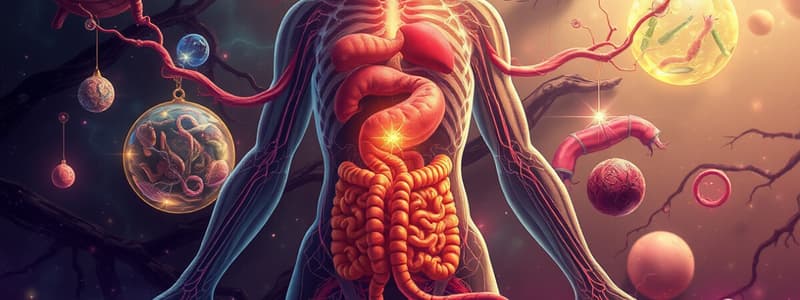Podcast
Questions and Answers
What are the major forms of nitrogenous wastes excreted by animals?
What are the major forms of nitrogenous wastes excreted by animals?
Ammonia, urea, and uric acid
Which nitrogenous waste is the most toxic and requires a large amount of water for elimination?
Which nitrogenous waste is the most toxic and requires a large amount of water for elimination?
- Ammonia (correct)
- Urea
- Uric acid
- Carbon dioxide
Ammonotelism refers to the excretion of uric acid.
Ammonotelism refers to the excretion of uric acid.
False (B)
Uricotelic animals excrete nitrogenous wastes as uric acid.
Uricotelic animals excrete nitrogenous wastes as uric acid.
What is the excretory structure in crustaceans like prawns?
What is the excretory structure in crustaceans like prawns?
The inner layer of the kidney includes an outer cortex and an inner ______.
The inner layer of the kidney includes an outer cortex and an inner ______.
What is the primary function of nephridia in annelids?
What is the primary function of nephridia in annelids?
What is the average weight of an adult human kidney?
What is the average weight of an adult human kidney?
Flashcards are hidden until you start studying
Study Notes
Excretory Products and Their Elimination
- Animals accumulate various excretory products including ammonia, urea, uric acid, carbon dioxide, water, and ions such as Na+, K+, Cl–, phosphate, and sulphate due to metabolic activities and excess ingestion.
- These waste products must be eliminated to maintain homeostasis in the body.
Nitrogenous Wastes
- Major forms of nitrogenous wastes include ammonia (most toxic), urea, and uric acid (least toxic).
- Ammonia requires large amounts of water for its elimination; uric acid can be excreted with minimal water loss.
- Ammonotelism refers to the excretion of ammonia, primarily seen in bony fishes, aquatic amphibians, and aquatic insects.
Excretion Mechanisms in Different Animals
- Ammonotelic animals excrete ammonia by diffusion across body surfaces or through gills, with kidneys playing a minor role.
- Terrestrial animals have adapted by producing less toxic wastes such as urea and uric acid, which conserve water.
- Ureotelic animals, such as mammals and many terrestrial amphibians, convert ammonia to urea in the liver before it is filtered by the kidneys.
- Uricotelic animals like reptiles, birds, and some insects excrete uric acid in a semi-solid form, minimizing water loss.
Excretory Structures in the Animal Kingdom
- Invertebrates typically have simple tubular excretory structures, while vertebrates possess complex kidneys.
- Protonephridia (or flame cells) are found in flatworms (e.g., Planaria), rotifers, certain annelids, and cephalochordates, focusing on osmoregulation.
- Nephridia are present in earthworms and help eliminate nitrogenous wastes while maintaining fluid balance.
- Malpighian tubules, found in most insects like cockroaches, assist in nitrogenous waste removal and osmoregulation.
- Antennal (green) glands in crustaceans (e.g., prawns) function in excretory processes.
Human Excretory System
- The human excretory system consists of two kidneys, two ureters, a urinary bladder, and a urethra.
- Kidneys are bean-shaped, reddish-brown structures located between the last thoracic and third lumbar vertebrae, measuring 10-12 cm in length and weighing 120-170 g.
- Each kidney has a hilum for the entry of ureters, blood vessels, and nerves, leading into the renal pelvis, which has projections known as calyces.
- The kidney structure includes an outer cortex and an inner medulla, with the medulla divided into conical masses called medullary pyramids.
Studying That Suits You
Use AI to generate personalized quizzes and flashcards to suit your learning preferences.




